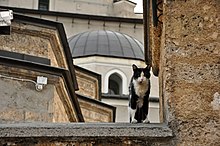

|
m →See also: removed irrelevant "see also" since it doesn't link to a page that exists
Tags: Mobile edit Mobile app edit Android app edit
|
added Category:Felines in religion using HotCat
|
||
| Line 39: | Line 39: | ||
[[Category:Animals in Islam]] |
[[Category:Animals in Islam]] |
||
[[Category:Cat folklore]] |
[[Category:Cat folklore]] |
||
[[Category:Felines in religion]] |
|||
This article's lead section may be too short to adequately summarize the key points. Please consider expanding the lead to provide an accessible overview of all important aspects of the article. (November 2023)
|

Admired for their cleanliness, the domestic cat is considered "the quintessential pet" by Muslims.[1]

The American poet and travel author Bayard Taylor (1825–1878) was astonished when he discovered a Syrian hospital where cats roamed freely. The institution, in which domestic felines were sheltered and nourished, was funded by a waqf, along with caretakers' wages, veterinary care, and cat food. Edward William Lane (1801–1876), a British Orientalist who resided in Cairo, described a cat garden originally endowed by the 13th-century Egyptian sultan Baibars.[1]
Wilfred Thesiger, in his book The Marsh Arabs, notes that cats were allowed free entry to community buildings in villages in the Mesopotamian Marshes and were even fed.[2][page needed] Aside from protecting granaries and food stores from pests, cats were valued by the paper-based Arab-Islamic cultures for preying on mice that destroyed books. For that reason, cats are often depicted in paintings alongside Islamic scholars and bibliophiles.
In Islamic tradition, cats are admired for their cleanliness. They are considered to be ritually clean, and are thus allowed to enter homes[1] and even mosques, including Masjid al-Haram. Food sampled by cats is considered halal, in the sense that their consumption of the food does not make it impermissible for Muslims to eat, and water from which cats have drunk is permitted for wudu (the ablution that is done by Muslims).[1] Furthermore, there is a belief among some Muslims that cats seek out people who are praying.[3]
Muslim scholars are divided on the issue of neutering animals. Most, however, maintain that neutering cats is allowed "if there is some benefit in neutering the cat and if that will not cause its death".[4] Muhammad ibn al Uthaymeen, a 20th-century Saudi Arabian Sunni imam, preached:
If there are too many cats and they are a nuisance, and if the operation will not harm them, then there is nothing wrong with it, because this is better than killing them after they have been created. But if the cats are ordinary cats and are not causing a nuisance, perhaps it is better to leave them alone to reproduce.[4]
Many Muslims believe that Muezza (orMuʿizza; Arabic: معزة) was Muhammad's favorite cat.[5][6] Muhammad awoke one day to the sounds of the adhan. Preparing to attend prayer, he began to dress himself; however, he soon discovered his cat Muezza sleeping on the sleeve of his prayer robe. Rather than wake her, he used a pair of scissors to cut the sleeve off, leaving the cat undisturbed. He then smiled and gently stroked his beloved cat three times, giving all cats the ability to land squarely on their feet.[5][6] There is no mention of any such cat or the associated story in the hadith or supplementary works[7] and there are similar stories attributed to someone else from 6th century Arabia which may explain the origin of the story.[8]
Stories of cats who seek out persons who are praying, and of cats sensitive to the presence of grace, are common.
In still another charming legend about the Prophet, one day his favorite cat Muezza bowed to thank him for some kind favor and, by this story, Muhammad then passed his hand down three times the length of the animal's back, giving to it—and to all cats evermore—the enviable capacity always to land squarely on their feet.